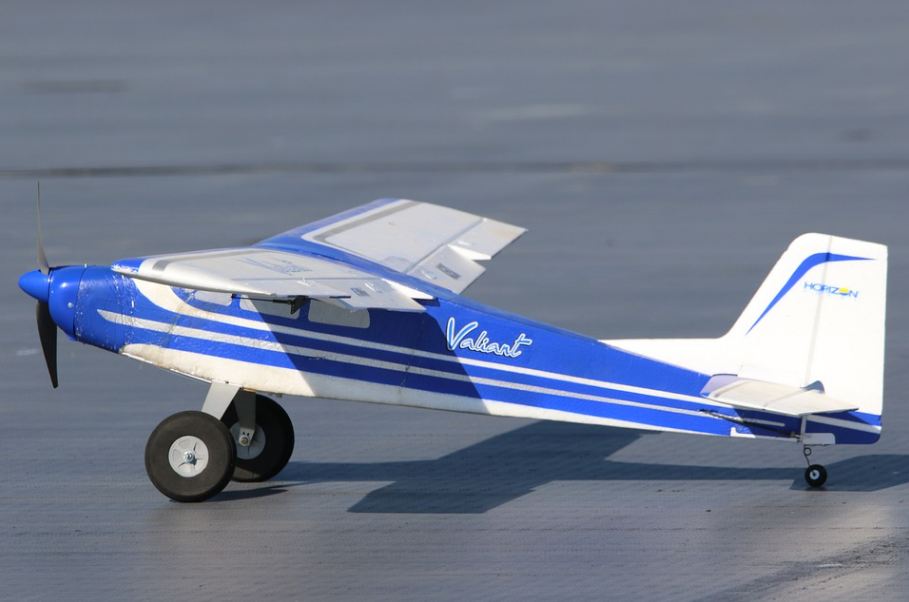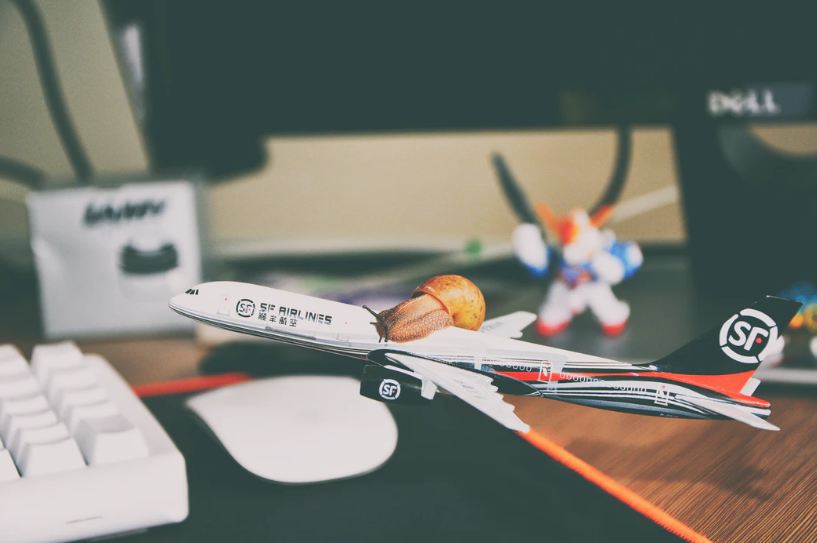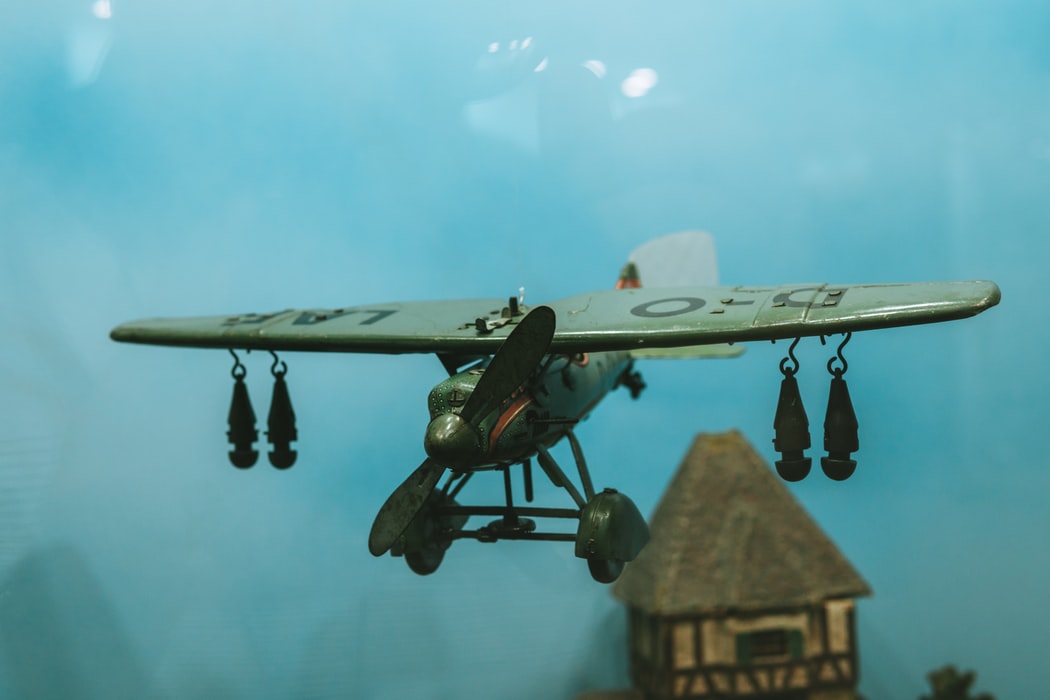Learning to Fly a Four-Channel RC Plane
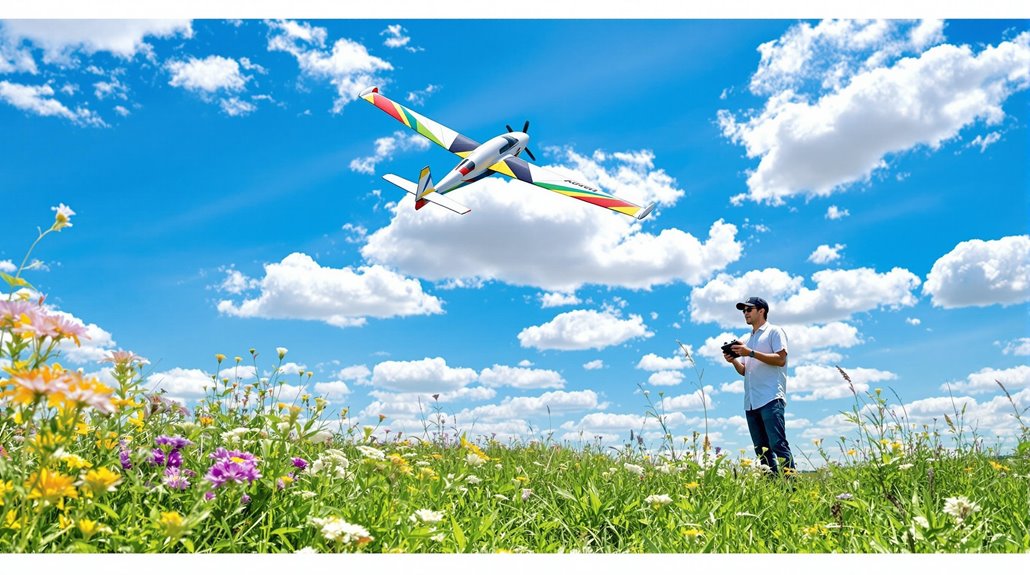
Learning to fly a four-channel RC plane is exciting and offers a unique challenge. You control the ailerons, elevators, rudder, and throttle, which lets you manage rolling, altitude, yaw, and speed. Start practicing in open spaces and keep your inputs smooth to avoid losing control. Conduct pre-flight checks on your equipment to ensure everything functions properly. Always maintain altitude and trim your controls for stable flight. Safety is key, so pick a clear area for flying. As you master the basics, you'll find plenty of tips and techniques that can enhance your flying skills even further.
Key Takeaways
- Start with thorough pre-flight checks, ensuring control surfaces are centered and battery levels are optimal for a safe flight.
- Use smooth and gradual inputs on ailerons and rudder during turns to maintain control and prevent stalling.
- Always practice in open areas, keeping a safe altitude of at least 100 feet for recovery from mistakes.
- Regularly trim your control surfaces during flight to maintain level flight and correct any erratic behaviors.
- Engage with online communities for tips, troubleshooting, and support to enhance your flying skills and knowledge.
Basics of RC Plane Flying
When learning to fly an RC plane, it's essential to grasp the basics of how control surfaces work. Ailerons, elevators, rudders, and throttle are your primary tools for maneuvering. Ailerons control the rolling motion, allowing for sharper turns, but be cautious—over-correcting can lead to loss of control. Elevators adjust altitude, while the rudder manages yaw, and throttle governs speed. In four-channel planes, ailerons and elevators are particularly sensitive, so practice is key.
Start by climbing to a safe height before making any turns, maintaining altitude with the up elevator during those maneuvers to ensure stable flight. In-flight trimming is crucial; it helps correct any unwanted tendencies, allowing your plane to fly straight and level with minimal manual input. Consider starting with a high-wing configuration plane, which offers enhanced stability and is ideal for beginners. Familiarize yourself with the circuit flying pattern, which consists of upwind, crosswind, downwind, and base legs. This knowledge is vital for preparing successful landings. By mastering these basics of RC plane flying, you'll build a solid foundation that enhances your flying experience and boosts your confidence as you take to the skies.
Essential Equipment and Supplies
To successfully navigate the world of RC plane flying, having the right equipment and supplies is crucial. For beginners learning how to fly a four-channel RC plane, a reliable FlySky FS-i6X Controller is essential equipment. This controller offers intuitive control with separate sticks for throttle, rudder, ailerons, and elevator, making it easier for you to master the basics.
You'll also need a FlySky Simulator Cable to connect your controller to a computer or simulator software. This setup allows you to practice virtually before taking to the skies, minimizing risk and boosting your confidence. The Clear View simulator is highly recommended, as it provides realistic flying experiences that help develop your skills.
Don't forget to invest in an RC Plane Trainer Kit, which includes a Brushless Motor, ESC, and Propellers. Assembling these components will deepen your understanding of how a four-channel plane operates. Brushless motors are powerful and long-lasting, ensuring optimal performance for your training plane. Lastly, always prioritize safety and conduct thorough pre-flight checks to ensure that all equipment is functioning correctly. Being well-prepared will enhance your learning experience and improve your flying precision.
Understanding Control Systems
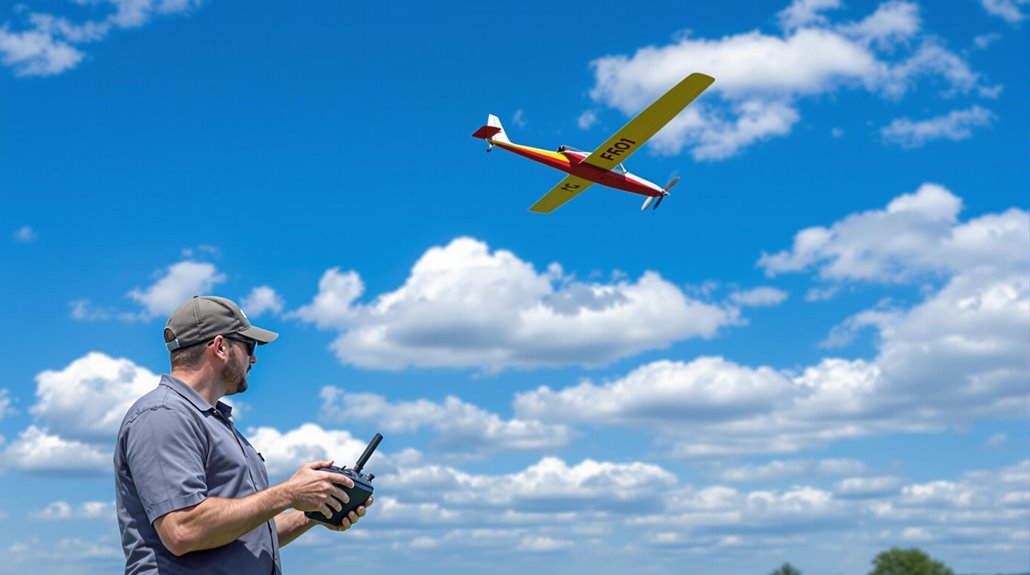
Once you've gathered your equipment and supplies, understanding the control systems of your four-channel RC plane becomes the next step in your flying journey. These systems include the throttle, rudder, elevator, and ailerons, each playing a crucial role in your plane's performance. The throttle controls the motor's speed, giving you the power to ascend or descend as needed.
The ailerons, which move in opposite directions, manage the rolling motion, allowing you to bank during turns. Meanwhile, the elevator adjusts altitude by creating downforce at the rear, and the rudder controls yaw, helping to rotate the nose of the plane relative to the ground.
Mastering these control surfaces is essential for executing advanced flying techniques like coordinated turns and maintaining altitude during maneuvers. Keep in mind that four-channel RC planes require more careful handling due to aileron sensitivity. Practice gentle and precise inputs to avoid losing control. Understanding the variety of RC planes available helps in choosing the right model for your skill level and flying style. By understanding these systems, you'll be better equipped to navigate the skies confidently and enjoy the full range of maneuvers your RC plane can perform.
Control Surfaces Explained
Understanding the control surfaces of your four-channel RC plane is crucial for mastering flight dynamics. These surfaces—ailerons, elevator, rudder, and throttle—each play a vital role in how your RC airplane maneuvers through the sky.
Ailerons, located on the wings, control the rolling motion of your plane. When one aileron moves up, the other moves down, allowing for smooth banked turns. This movement helps you navigate left or right effectively. The elevator, positioned at the tail, is essential for adjusting altitude. By changing the airflow, it creates downforce; moving it upward makes the plane climb.
The rudder, found on the vertical stabilizer, manages the yaw of your aircraft. It lets you rotate the nose left or right during turns, enhancing your control during flight. Lastly, the throttle manages the speed of the motor. Unlike the other controls, it doesn't self-center, giving you the flexibility to adjust power settings as needed. Always conduct pre-flight inspections to ensure the plane's condition is optimal before takeoff.
Basic Flying Techniques
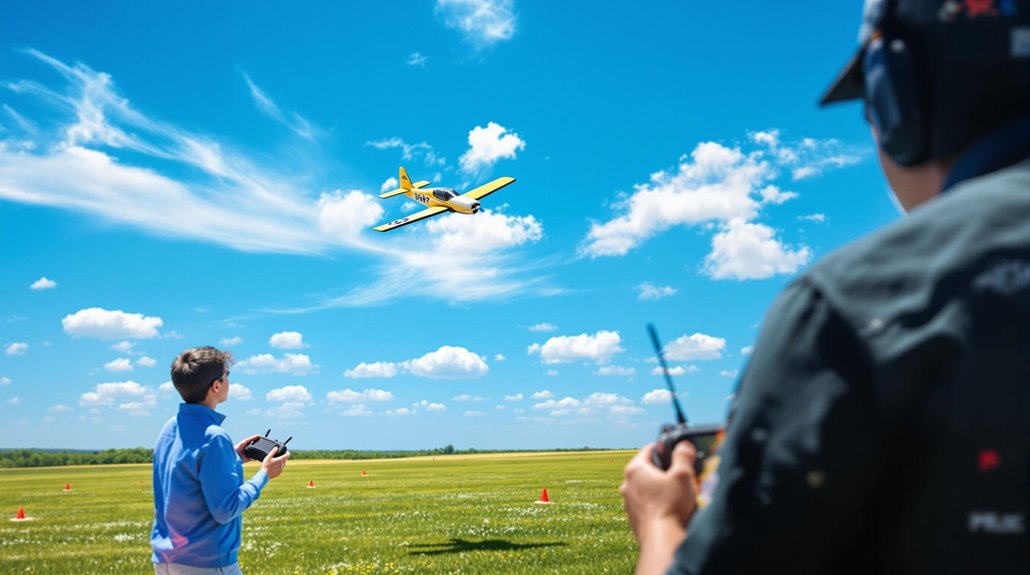
Mastering the control surfaces of your RC plane sets the stage for effective flying techniques. After takeoff, climb to a safe altitude—typically around 100 feet—before making any turns. This height gives you better visibility and control. When turning, use smooth and gradual inputs on the rudder or ailerons. Reduce your throttle to about three-quarters to maintain altitude and avoid stalling.
Remember, when flying towards yourself, the controls are reversed; left becomes right, and vice versa. This requires careful adjustments to maneuver accurately. To maintain stability, keep your turns gentle and avoid over-correcting, as excessive inputs can lead to loss of control and crashes. Practicing this will enhance your hand-eye coordination, essential for flying an RC effectively.
Always choose open spaces away from people and obstacles for practice. Aim to keep at least two mistakes high—this means you should have enough altitude to recover from potential errors. By following these basic flying techniques, you'll build a solid foundation for your RC flying skills, ensuring a safer and more enjoyable experience. When selecting an RC trainer plane, consider the types of wings available, as they significantly affect the stability and learning curve for beginners.
Circuit Flying Patterns
Circuit flying patterns are essential for every RC pilot, as they provide a structured approach to navigating the sky. This involves flying in a rectangular path consisting of four legs: upwind, crosswind, downwind, and base. Practicing these patterns helps you establish organized flight paths and simplifies your landing approach.
When you fly the circuit, aim to maintain a consistent altitude. Use a small amount of up elevator to counteract any altitude loss during turns. It's also crucial to practice the circuit in both directions at various heights, as this develops your muscle memory and enhances your navigation skills. Always fly the circuit at least two mistakes high; this gives you ample altitude to recover if you make an error.
As you repeat circuit flying, you'll find that it prepares you for landing approaches. Understanding how to align with the runway is vital, and practicing the circuit will help you do just that. Remember, staying in a straight line along each leg of the circuit is key to mastering this skill and becoming a proficient RC pilot.
In-Flight Adjustments
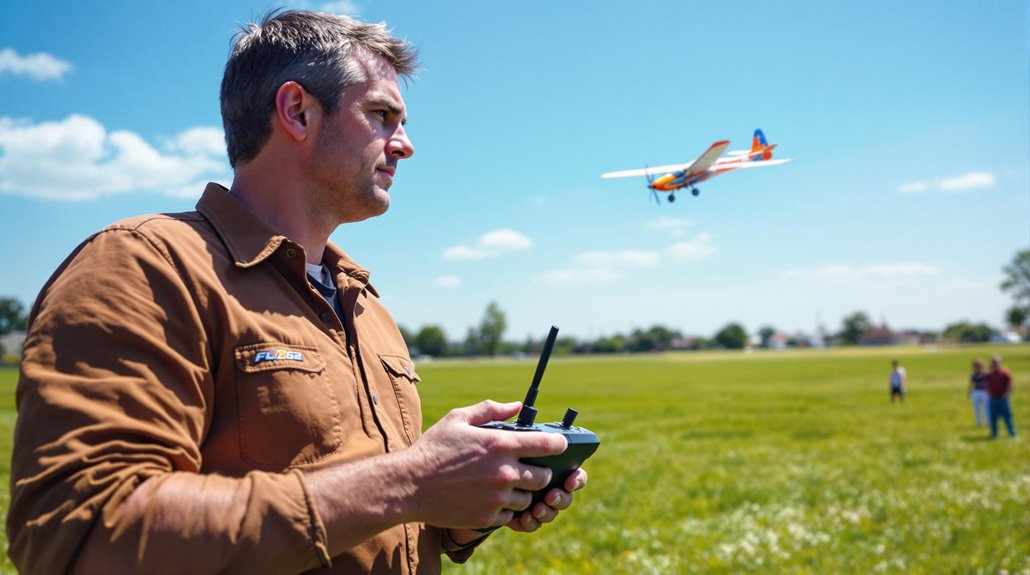
How can you ensure your RC plane flies smoothly throughout your flight? The key is making in-flight adjustments to keep your aircraft stable. Start by trimming your plane while it's in the air. Use the transmitter trims to tweak the control surfaces, correcting any tendencies like turning or climbing. This way, you can maintain a straight and level flight path with minimal pilot input. Regular in-flight trimming reduces your workload, which is crucial for four-channel planes due to their sensitivity. If your plane starts behaving erratically, don't panic.
Calmly assess the situation and cut the motor power to reduce airspeed if needed. Use elevator controls to regain control from unexpected dives or climbs. Before your flight, ensure that all control surfaces are centered. This establishes a baseline, making in-flight adjustments more intuitive. Remember, small tweaks can make a big difference, so don't hesitate to make those adjustments as needed.
By mastering these techniques, you'll enhance your flying experience and keep your RC plane soaring smoothly through the skies. To optimize your RC experience, consider the choice between nitro propulsion and electric power sources, as it influences the maintenance and performance characteristics of your model.
Safety and Preparation
Maintaining a smooth flight isn't just about in-flight adjustments; it starts well before you take to the skies. Your safety and preparation are paramount, so make thorough pre-flight checks a routine. Ensure all components, especially control surfaces and battery levels, are functioning properly before each flight. Familiarizing yourself with weight and balance principles can optimize performance and prevent crashes due to improper loading.
Continuous signal transmission is essential for operation, as loss of signal may result in crashes or collisions. Choosing the right flying location is crucial. Look for areas away from people, animals, and obstacles to minimize risks during practice. This way, you create a safe environment for both yourself and others. Before you launch, also understand and practice correct take-off and landing techniques. Mastering gliding approaches and throttle management enhances safety during these critical phases of flight. Finally, always prioritize situational awareness.
Keep your plane in sight at all times, and avoid maneuvers that could lead to disorientation or loss of control. With proper safety measures and thorough preparation, you'll be well-equipped for a successful flying experience, allowing you to focus on enjoying the thrill of piloting your RC plane.
Community and Resources
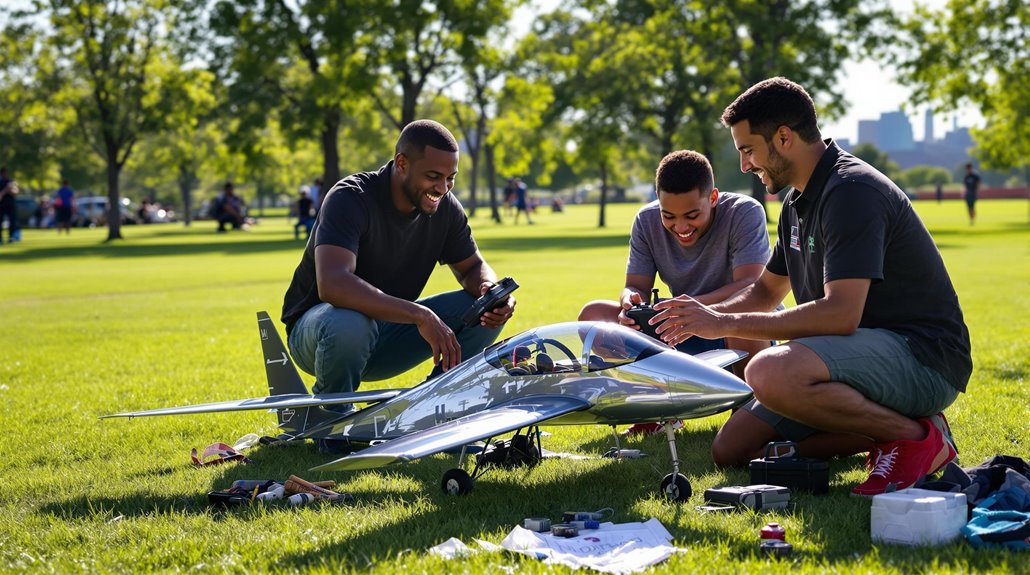
Joining the vibrant RC flying community can significantly enhance your experience as a pilot. By participating in platforms like the Flite Test Forums, you'll gain access to a treasure trove of knowledge with over 7.5K threads and 108.9K messages dedicated to RC flying discussions. Here, you can introduce yourself in the designated section, fostering connections with fellow enthusiasts who share your passion.
The forums feature specialized sub-forums such as Electric Aircraft and Specialty Flying, allowing you to find targeted advice tailored for four-channel RC planes. Engaging with the community not only helps you seek product suggestions and troubleshooting advice, but it also lets you share personal safety stories, enriching the learning experience for everyone.
RC planes are suitable for all ages, making them an excellent choice for family enjoyment and bonding through shared flying experiences.
One of the standout features of this community is the Mentors section. Here, you can connect with seasoned pilots who are eager to guide you as you navigate the complexities of flying. Having a mentor can provide invaluable support, helping you build confidence and skill as you learn to fly your four-channel RC plane. Embrace the resources available, and you'll find that you're never alone on your flying journey.


